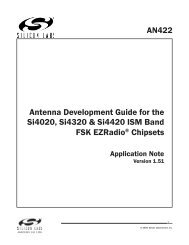C8051F326/7 - Silicon Labs
C8051F326/7 - Silicon Labs
C8051F326/7 - Silicon Labs
You also want an ePaper? Increase the reach of your titles
YUMPU automatically turns print PDFs into web optimized ePapers that Google loves.
6.3.2. External Interrupts<br />
<strong>C8051F326</strong>/7<br />
The /INT0 external interrupt source can be configured as edge or level sensitive. The IT0 bit (TCON.0, see<br />
Figure 14.1 on Page 128) selects level or edge sensitivity. When global port I/O inputs are enabled, /INT0<br />
will monitor the voltage at the input pin. The CPU will vector to the /INT0 interrupt service routine whenever<br />
the pin detects the condition the external interrupt has been configured to monitor. TMOD.3 (GATE0) controls<br />
the functionality of /INT0 as is shown in Table 6.4.<br />
The /INT1 interrupt source provides an interrupt on two events, based on the logic level of GATE1<br />
(TMOD.7). If GATE1 is set to logic 1, an interrupt is generated every two Low Frequency Internal Oscillator<br />
clock cycles. This allows the CPU to vector to the /INT1 interrupt service routine at a rate of 40 kHz. If<br />
GATE1 is set to logic 0, an interrupt is generated when the internal oscillator resumes from a suspended<br />
state.<br />
The pending flags for the /INT0 and /INT1 interrupts are set upon reset. If the /INT0 or /INT1 interrupt is<br />
used, the respective flag should be cleared before enabling the interrupts to prevent an accidental interrupt.<br />
The pending flags are for the /INT0 and /INT1 interrupt are in the TCON register.<br />
6.3.3. Interrupt Priorities<br />
Each interrupt source can be individually programmed to one of two priority levels: low or high. A low priority<br />
interrupt service routine can be preempted by a high priority interrupt. A high priority interrupt cannot be<br />
preempted. Each interrupt has an associated interrupt priority bit in an SFR (IP or EIP2) used to configure<br />
its priority level. Low priority is the default. If two interrupts are recognized simultaneously, the interrupt with<br />
the higher priority is serviced first. If both interrupts have the same priority level, a fixed priority order is<br />
used to arbitrate, given in Table 6.5.<br />
6.3.4. Interrupt Latency<br />
Table 6.4. TMOD.3 Control of /INT0<br />
TMOD.3 = 0 TMOD.3 = 1<br />
/INT0 Pinout P0.0 P0.2<br />
Edge Sensitivity Rising Edge Falling Edge<br />
Level Sensitivity Active High Active Low<br />
Interrupt response time depends on the state of the CPU when the interrupt occurs. Pending interrupts are<br />
sampled and priority decoded each system clock cycle. Therefore, the fastest possible response time is 5<br />
system clock cycles: 1 clock cycle to detect the interrupt and 4 clock cycles to complete the LCALL to the<br />
ISR. If an interrupt is pending when a RETI is executed, a single instruction is executed before an LCALL<br />
is made to service the pending interrupt. Therefore, the maximum response time for an interrupt (when no<br />
other interrupt is currently being serviced or the new interrupt is of greater priority) occurs when the CPU is<br />
performing an RETI instruction followed by a DIV as the next instruction. In this case, the response time is<br />
18 system clock cycles: 1 clock cycle to detect the interrupt, 5 clock cycles to execute the RETI, 8 clock<br />
cycles to complete the DIV instruction and 4 clock cycles to execute the LCALL to the ISR. If the CPU is<br />
executing an ISR for an interrupt with equal or higher priority, the new interrupt will not be serviced until the<br />
current ISR completes, including the RETI and following instruction.<br />
The CPU is stalled during Flash write/erase operations. Interrupt service latency will be increased for interrupts<br />
occurring while the CPU is stalled. The latency for these situations will be determined by the standard<br />
interrupt service procedure (as described above) and the amount of time the CPU is stalled.<br />
Rev. 1.1 49


